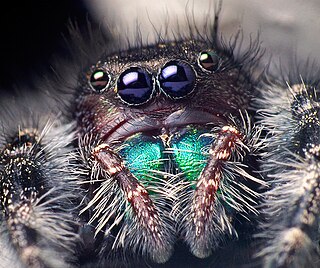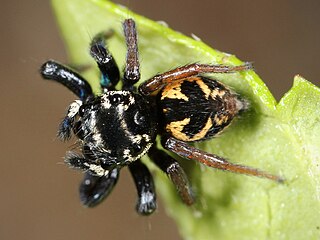
The Thomisidae are a family of spiders, including about 170 genera and over 2,100 species. The common name crab spider is often linked to species in this family, but is also applied loosely to many other families of spiders. Many members of this family are also known as flower spiders or flower crab spiders.

Phidippus is a genus in the family Salticidae. Some of the largest jumping spiders inhabit this genus, and many species are characterized by their brilliant, iridescent green chelicerae. Phidippus is distributed almost exclusively in North America, with the exception of two exported species. As of January 2021, there were about 80 described species in the genus. Species previously described in Phidippus which are found in India and Bangladesh do not belong in this genus.
Asaracus is a genus of South American jumping spiders that was first described by Carl Ludwig Koch in 1846.

Corythalia is a genus of jumping spiders that was first described by Carl Ludwig Koch in 1850. The genus is distributed throughout most of the Western Hemisphere. Species of this genus are found in The Americas.

Pachomius is a genus of jumping spiders that was first described by George and Elizabeth Peckham in 1896. Uspachia was merged into genus Romitia in 2007, and all nine species were merged into Pachomius in 2015. The name is derived from Pachomius, the founder of cenobitic monasticism.
Platypsecas is a monotypic genus of Venezuelan jumping spiders containing the single species, Platypsecas razzabonii. It was first described by Lodovico di Caporiacco in 1955, and is only found in Venezuela. The type locality is El Junquito in the Capital District. Gustavo R. S. Ruiz and Antonio D. Brescovit though the genus was "possibly in Euophryinae"; Wayne P. Maddison followed their "tentative suggestion" and classified the genus in the tribe Euophryini within the clade Saltafresia and subfamily Salticinae.
Tomis is a genus of South American jumping spiders that was first described by F.O. Pickard-Cambridge in 1901. The genus Pseudattulus, erected by Lodovico di Caporiacco in 1947, was formerly considered distinct with two species, but was placed in synonymy in 2020 when Tomis was re-separated from Sitticus.

Sassacus is a genus of jumping spiders that was first described by George and Elizabeth Peckham in 1895. It is likely named after Sassacus, a Native American chief of the 16th and 17th century.
Pseudonemesia is a genus of spiders in the family Microstigmatidae, found in Colombia and Venezuela.
Aljassa is a genus of South American anyphaenid sac spiders first described by Antônio Brescovit in 1997.

Hapalopus is a genus of tarantulas that was first described by Anton Ausserer in 1875.
Schismatothele is a genus of South American tarantulas that was first described by Ferdinand Anton Franz Karsch in 1879.
Pseudosparianthis is a genus of huntsman spiders that was first described by Eugène Louis Simon in 1887.
Sparianthina is a genus of huntsman spiders that was first described by Nathan Banks in 1929.
Sparianthis is a genus of huntsman spiders, first described by Eugène Louis Simon in 1880. They’re found in South America and Panama.
Vindullus is a genus of huntsman spiders that was first described by Eugène Louis Simon in 1880. Though often considered a synonym of Olios, it has been validated as its own genus.
Haedanula is a monotypic genus of African crab spiders containing the single species, Haedanula subinermis. It was first described by Lodovico di Caporiacco in 1941, and is found in Ethiopia.

Odo is a genus of spiders in the family Xenoctenidae, containing 25 species occurring in Central and South America, and Australia.

Xenoctenidae is a family of araneomorph spiders separated from Miturgidae in 2017.
Erendira is a genus of corinnid sac spiders first described by A. B. Bonaldo in 2000.







